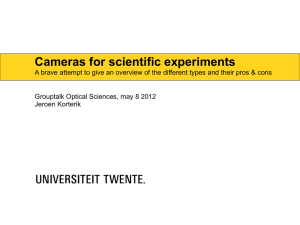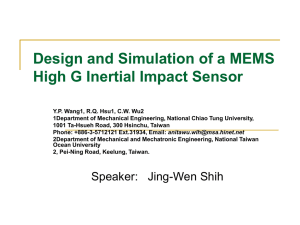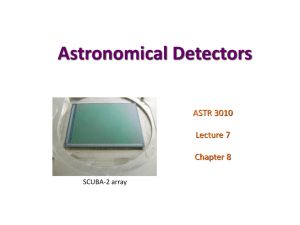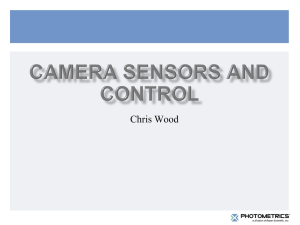Measurements (final) - Type of sensors
advertisement
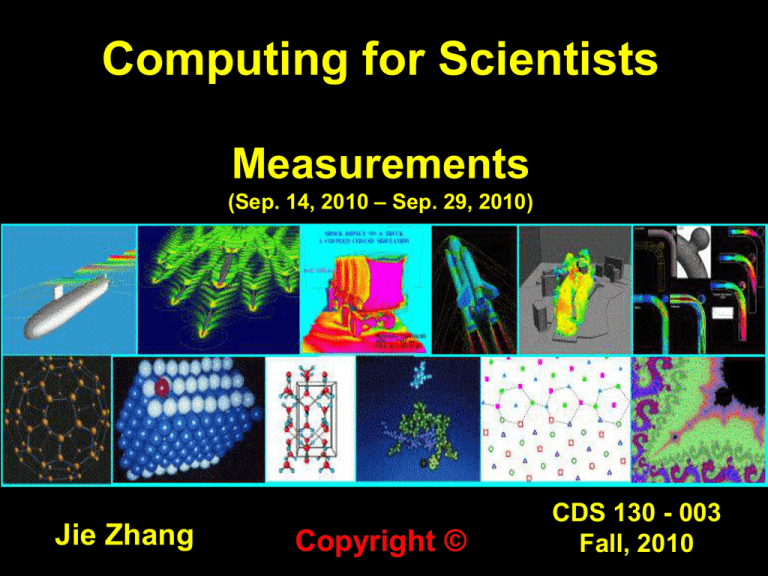
Computing for Scientists Measurements (Sep. 14, 2010 – Sep. 29, 2010) Jie Zhang Copyright © CDS 130 - 003 Fall, 2010 Measurements 1. How sensors measure scientific data? 2. Issues with sensor? • Sensor is not perfect; it has limitations 3. Issues with data? • Signal and noise Sensors (Sep. 14, 2010) Objectives •How does a sensor work? •Different types of sensors Sensor A sensor is a device that measures a physical quantity and converts it into a signal which can be read by an observer or by an instrument. http://en.wikipedia.org/wiki/Sensor Thermometer Thermometer biosensor Electric Measurement Most sensors are electric-based, converting physical signal into electric signal: electric voltage and/or electric current R: the resistance of the conductor in units of Ohms V: the potential difference measured across the resistance in units of Volts I: the current through the resistance in units of Amperes Electric Measurement V I R Ohm’s Law I = V /R V=IR R = V/I Ohm's law states that the current through a conductor between two points is directly proportional to the potential difference or voltage across the two points, and inversely proportional to the resistance between them Electric Measurement Water Flow Analogy Question? In a clear day, a 10 inch by 8 inch solar panel can generate a voltage potential of 20 volts at the output. If a 40 Ohms resistance is connected to it, what is the electric current flowing through the circuit? CCD Charge-Coupled Device: A sensor of electromagnetic radiation Biosensor for imaging CCD sensor for imaging: the eyes of digital world CCD http://en.wikipedia.org/wiki/Charge-coupled_device •CCD was invented in 1969 at AT&T Bell Labs by Willard Boyle and George E. Smith •In 1969, the CCD was a simple 8-bit shift register •In 1974, a 2-D 100 X 100 pixel device •Sony managed to mass produce CCDs for camcorders •In 2009, Boyle and Smith were awarded the Nobel Prize for Physics for their work on CCD CCD - Operation •In a CCD for capturing images, there is a photoactive layer (region) and a transmission layer (region). •The photoactive region is an array of capacitor (pixel); each capacitor accumulate an electric charge proportional to the light intensity striking at that location •After the exposure to the array, a control circuit causes each capacitor to transfer its contents to its neighbor (operating as a shift register). The last capacitor in the array dumps its charge into a reader, which is converted to a readable voltage and saved. CCD - Operation Charge Accumulation: more photons, more charges during the exposure time CCD - Operation Charge Transfer: The charge packets (electrons, blue) are collected in potential wells (yellow) created by applying positive voltage at the gate electrodes (G). Applying positive voltage to the gate electrode in the correct sequence transfers the charge http://en.wikipedia.org/wiki/Charge-coupled_device CCD - Operation Color CCD: Digital color cameras generally use a Bayer mask over the CCD. Each square of four pixels has one filtered red, one blue, and two green. The result of this is that luminance information is collected at every pixel, but the color resolution is lower than the luminance resolution Biosensor http://en.wikipedia.org/wiki/Biosensor A biosensor is an analytical device for the detection of an analyte that combines a biological component with a physico-chemical detector component. It consists of 3 parts 1. the sensitive biological element (biological material (e.g. tissue, microorganisms, cell receptors, enzymes, antibodies, nucleic acids)) 2. the detector element that transforms the signal resulting from the interaction of the analyte with the biological element into another signal that can be more easily measured and quantified 3. associated electronics or signal processors that are primarily responsible for the display of the results in a user-friendly way Exp: blood glucose biosensor Sensor Types •Imaging: CCD detectors •Temperature •Pressure •Chemical Sensors: •Carbon Monoxide Detector •Motions Sensors •Biosensor •……… Summary •Nearly all sensors use or can use electrical measurements •Ohm's law governs electrical circuits •Sensors can be broken into different classes, depending on what things they measure, e.g., CCD, glucose sensor •Good sensors measure what they are suppose to measure, and not disturb the experiments Sensor Limitations (Sep. 16, 2010) Objectives •What is lower and upper limits? •In terms of magnitude or intensity •What is resolution? •In terms of space and time •Calibration issues •linearity Lower Limit •Any measurement below this point is recorded as just zero or noise •All sensors have lower limits •Temperature sensors have minimum temperature •CCD has a minimum level of light, which is considered “not a noise” Upper Limit •Any measurement beyond this point is recorded as the same value, or zero, or as corrupted •It causes saturation, which should be avoided for most of data collection •Examples •Temperatures larger 140 degrees are recorded as 140 degrees •Wind speeds larger than 250 mph cannot be recorded •Voltages greater than 10,000 volts cause the voltmeter to fail •SOHO satellite records the magnetic field on the Sun larger than 3000 Gauss as zero, a big headache for scientists. Resolution in Time •Also called “temporal resolution” •Sensors take time to measure a signal •Time for the signal to built up •Electric charges to build up in CCD pixels, e.g., the exposure time •Time to read the data from the censor •CCD readout time, e.g., 1 second Resolution in Space •Also called “spatial resolution” •It describes the detail an image holds. Higher resolution means more image details, e.g., number of pixels, dots per inch •Monitors •CCD cameras and camcorders •Projectors •Printers Resolution in Levels •Limits the precision of measurements •It is limited by the sensitivity of sensors •It is also limited by the resolution of the Analog to Digital Converter (ADC) •Number of bits used to store data •8 bits: 256 levels •10 bits: 1024 levels •12 bits: 4096 levels ADC http://en.wikipedia.org/wiki/Analog-to-digitanl_converter •An analog-to-digital converter (abbreviated ADC is a device that converts a continuous quantity to a discrete digital number •Typically, it converts an input analog voltage (or current to a digital number proportional to the magnitude of the voltage or current. Resolution in Levels A typical home outdoor electrical temperature sensors has an operational range between 140 and -40 degree in Fahrenheit , and use 12 bits to convert(abbreviated the data. WhatADC is •An analog-to-digital converter thea resolution of the detector? is device that converts a continuous quantity to a I max I min R N I max 140 I min 40 N 212 4096 R 0.044 F What is the resolution if the ADC is 8 bits? Linearity •A desirable feature of a sensor is Linearity: the measured signal is proportional to the input signal Linear Non-Linear Data Limitations -Signal and Noise (Sep. 29, 2010) Motivation The data we get from sensors is not perfect. Every measurement has noise and limitations, both from the sensor and other random factors. We need to understand noise, in order to fully understand scientific measurements What Happens to Stars? Constellation Orion in the Country Constellation Orion in the City Signal to Noise Ratio (SNR) http://www.dspguide.com/ch25/3.htm Objectives •Understand what are signal, noise and background. •Do calculation of SNR (Signal to Noise Ratio) Signal, Noise and Background A Measurement Signal, Noise and Background •The background is an average of the values when there is no signal •The noise describes variations in the background •The signal is the value of the peak MINUS the background Signal to Noise Ratio (SNR) The signal to noise ratio (SNR) is the ratio between the signal and the noise In previous figure: •The peak is about 27500 •The background is about 25000 •The signal is 2500 = 27500-25000 •The noise is about 150 •The signal to noise ratio = 2500/150 = 16.6 Signal to Noise Ratio (SNR) •Most noise in scientific measurements follows Poisson distribution •Poisson noise is equal to the square root of the background level •A SNR of 3 is often required as a minimum to ensure that the measurement is a true signal The End (Sep. 28, 2010) Note: In the week of Sep. 20 to Sep. 24, 2010, Joe made a tutorial on Matlab.




